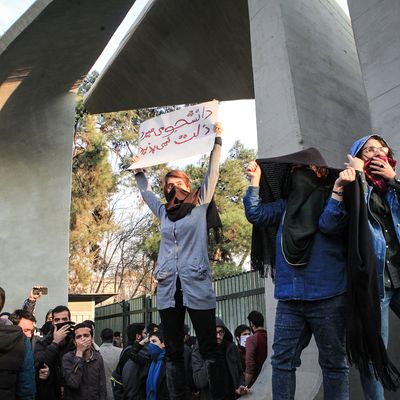
North and South Koreans got together this week to tell Washington, ever so politely, to hold off on the nuclear apocalypse while they get in some ice-skating first. And President Trump, apparently, told South Korea’s President Moon that he absolutely was not thinking of a preventive attack on the North — but that he would consider meeting with Kim Jong-un.
But lest you fear that you will have no nuclear drama to go with your ice-skating, Iran has got your back. As the Iranian people continue to stage protests against their government, Washington has manufactured yet more drama with another series of “kill the Iran deal” deadlines hitting this Friday.
When last we left the debate over the Obama administration’s deal with Iran and other major powers to halt Iran’s nuclear program in exchange for sanctions relief, President Trump had “decertified” the deal but not actually moved to reinstate the sanctions that would kill it and give Iran the green light to restart a nuclear-weapons program. Instead, he challenged Congress to come up with a new package of sanctions — and a new procedure to decide whether or not Iran is in compliance with the 2015 deal.
Since then, 90 days have ticked by. Congress does not have a piece of legislation ready, and so the law saying the president must certify every three months that Iran is in compliance with the deal is still in force. Just as was the case three months ago, U.S. and international observers agree Iran is meeting the letter of the deal. Just as was the case three months ago, observers across the political spectrum agree that Iran is supporting extremist groups and destabilizing U.S. allies across the Middle East, from Yemen to Iraq, Syria, Lebanon, and Palestine. And just as was the case three months ago, even national-security observers who disliked the nuclear deal when it was signed think that tearing it up now doesn’t help address those other regional security challenges.
Of course, Trump still hates the deal.
But one major thing has changed — massive, spontaneous popular protests are continuing to reverberate across Iran. Many of the demonstrators seem to share Washington’s negative view of Iran’s regional security interventions. “Leave Syria and Think of Us” was a popular protest sign. However, the demonstrators don’t seem to align with Iran’s prior protest movements, led by urban progressives. Both reformers and conservatives have tried to take advantage of the protests to put more blame on the current government. That government had promised big improvements in the lives of everyday Iranians, improvements it was hoping to pay for through sanctions relief under the nuclear deal.
Although Washington experts have spent a fair amount of time on Twitter fighting about what the protests mean, and what the U.S. should do in response, literally no one has changed his or her opinion about the Iran deal in response to the protests. The conservatives who opposed it before are now sure that getting rid of it could be the blow that brings down the regime. The liberals who favored it believe it is critical to staving off war, regardless of what social change is raging. Perhaps most interesting is that the world leaders who initially opposed it, then accepted it grudgingly as a bulwark of stability still do.
All those signs seem to point to the last 90 days being the new normal. The deal is decertified but still operating. The president can make a fiery speech on Friday denouncing Iran’s treatment of protesters and its shipment of weapons to Hezbollah and leave every single provision in place. And perhaps — as the AP now reports — he will recertify the deal after doing so. So don’t worry about the drama abating — in 90 days we’ll likely get to play the same suspenseful guessing game again.
However, it seems worth learning from the Iranian protesters, brave men and even braver women who didn’t listen to the experts and felt they had nothing left to lose. The history of popular uprisings in the last decade should tell us never to count their energy out — and never to assume that we have any idea how, or under whom, popular energy will be channeled. With the Iranian government under siege, and the hardest-line forces one of the possible winners from internal unrest, now is the worst time to send mixed signals, contradictory messages, or frenzied, inflammatory tweets. Getting rid of the 90-day reviews with the deal clearly in place would send an all-too-rare unified message from Washington to Iranians: Americans don’t want your government to be spending its resources on nuclear weapons. And we’re not going to give the bellicose forces in your society an excuse to ramp nuclear spending back up.





























